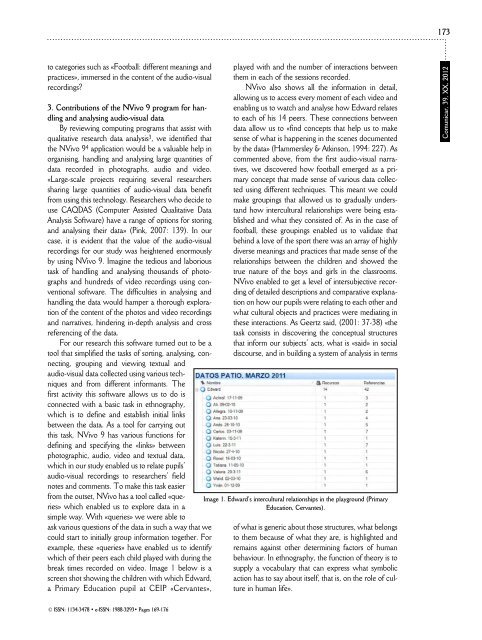Comunicar 39-ingles - Revista Comunicar
Comunicar 39-ingles - Revista Comunicar
Comunicar 39-ingles - Revista Comunicar
You also want an ePaper? Increase the reach of your titles
YUMPU automatically turns print PDFs into web optimized ePapers that Google loves.
173to categories such as «Football: different meanings andpractices», immersed in the content of the audio-visualrecordings?3. Contributions of the NVivo 9 program for handlingand analysing audio-visual dataBy reviewing computing programs that assist withqualitative research data analysis 3 , we identified thatthe NVivo 9 4 application would be a valuable help inorganising, handling and analysing large quantities ofdata recorded in photographs, audio and video.«Large-scale projects requiring several researcherssharing large quantities of audio-visual data benefitfrom using this technology. Researchers who decide touse CAQDAS (Computer Assisted Qualitative DataAnalysis Software) have a range of options for storingand analysing their data» (Pink, 2007: 1<strong>39</strong>). In ourcase, it is evident that the value of the audio-visualrecordings for our study was heightened enormouslyby using NVivo 9. Imagine the tedious and laborioustask of handling and analysing thousands of photographsand hundreds of video recordings using conventionalsoftware. The difficulties in analysing andhandling the data would hamper a thorough explorationof the content of the photos and video recordingsand narratives, hindering in-depth analysis and crossreferencing of the data.For our research this software turned out to be atool that simplified the tasks of sorting, analysing, connecting,grouping and viewing textual andaudio-visual data collected using various techniquesand from different informants. Thefirst activity this software allows us to do isconnected with a basic task in ethnography,which is to define and establish initial linksbetween the data. As a tool for carrying outthis task, NVivo 9 has various functions fordefining and specifying the «links» betweenphotographic, audio, video and textual data,which in our study enabled us to relate pupils’audio-visual recordings to researchers’ fieldnotes and comments. To make this task easierfrom the outset, NVivo has a tool called «queries»which enabled us to explore data in asimple way. With «queries» we were able toask various questions of the data in such a way that wecould start to initially group information together. Forexample, these «queries» have enabled us to identifywhich of their peers each child played with during thebreak times recorded on video. Image 1 below is ascreen shot showing the children with which Edward,a Primary Education pupil at CEIP «Cervantes»,played with and the number of interactions betweenthem in each of the sessions recorded.NVivo also shows all the information in detail,allowing us to access every moment of each video andenabling us to watch and analyse how Edward relatesto each of his 14 peers. These connections betweendata allow us to «find concepts that help us to makesense of what is happening in the scenes documentedby the data» (Hammersley & Atkinson, 1994: 227). Ascommented above, from the first audio-visual narra -tives, we discovered how football emerged as a primaryconcept that made sense of various data collectedusing different techniques. This meant we couldmake groupings that allowed us to gradually understandhow intercultural relationships were being establishedand what they consisted of. As in the case offootball, these groupings enabled us to validate thatbehind a love of the sport there was an array of highlydiverse meanings and practices that made sense of therelationships between the children and showed thetrue nature of the boys and girls in the classrooms.NVivo enabled to get a level of intersubjective recordingof detailed descriptions and comparative explanationon how our pupils were relating to each other andwhat cultural objects and practices were mediating inthese interactions. As Geertz said, (2001: 37-38) «thetask consists in discovering the conceptual structuresthat inform our subjects’ acts, what is «said» in socialdiscourse, and in building a system of analysis in termsImage 1. Edward’s intercultural relationships in the playground (PrimaryEducation, Cervantes).of what is generic about those structures, what belongsto them because of what they are, is highlighted andremains against other determining factors of humanbehaviour. In ethnography, the function of theory is tosupply a vocabulary that can express what symbolicaction has to say about itself, that is, on the role of culturein human life».<strong>Comunicar</strong>, <strong>39</strong>, XX, 2012© ISSN: 1134-3478 • e-ISSN: 1988-3293• Pages 169-176
















